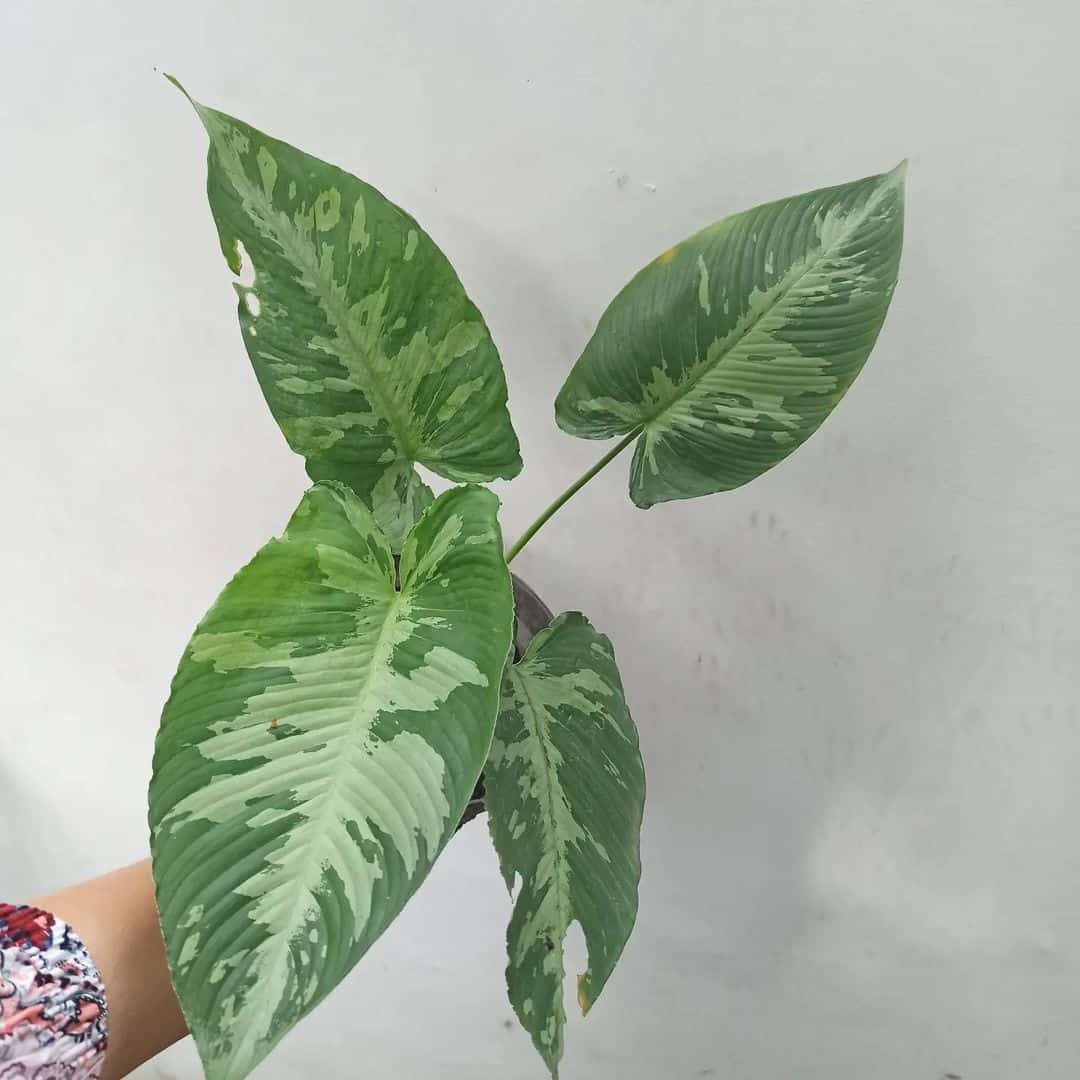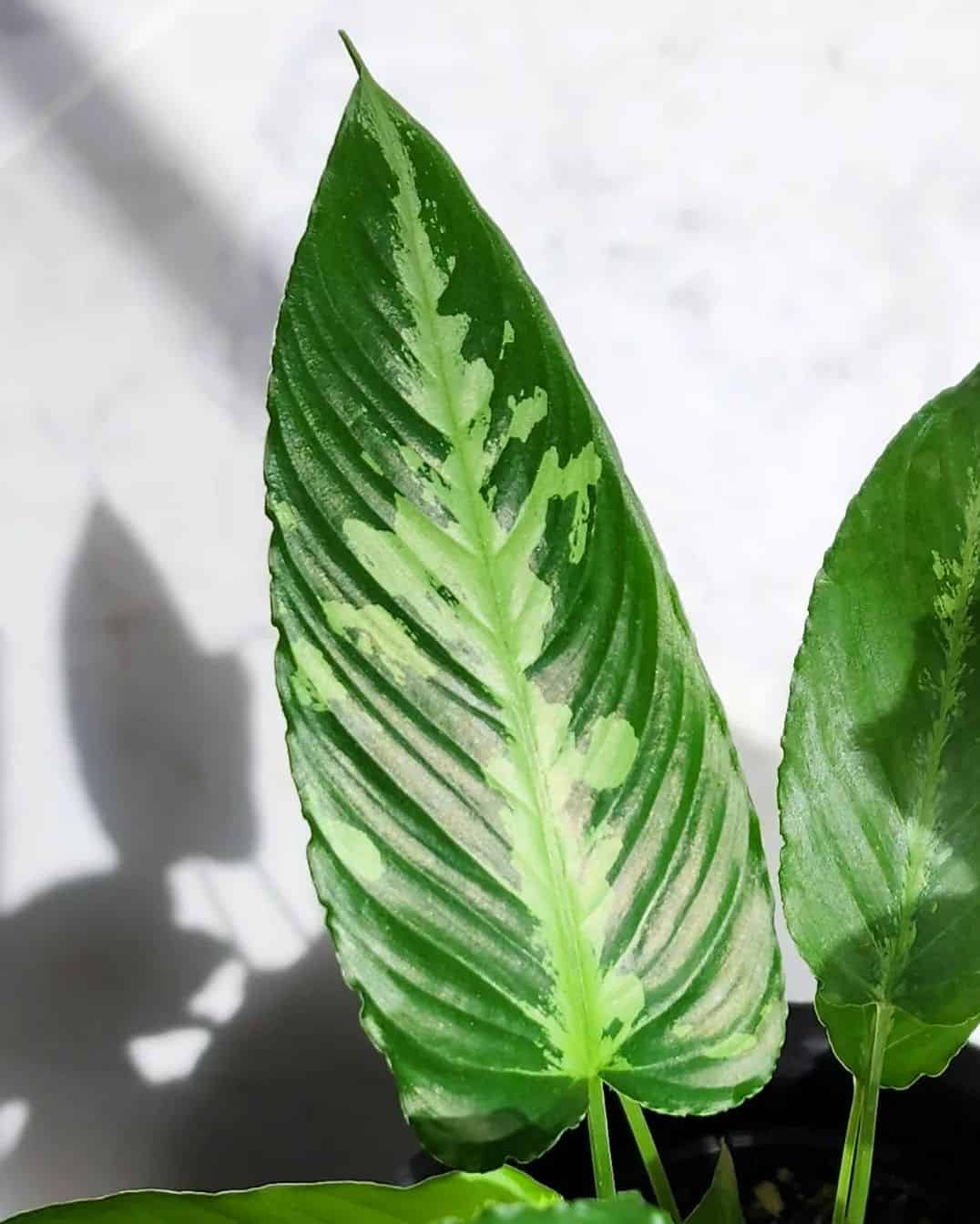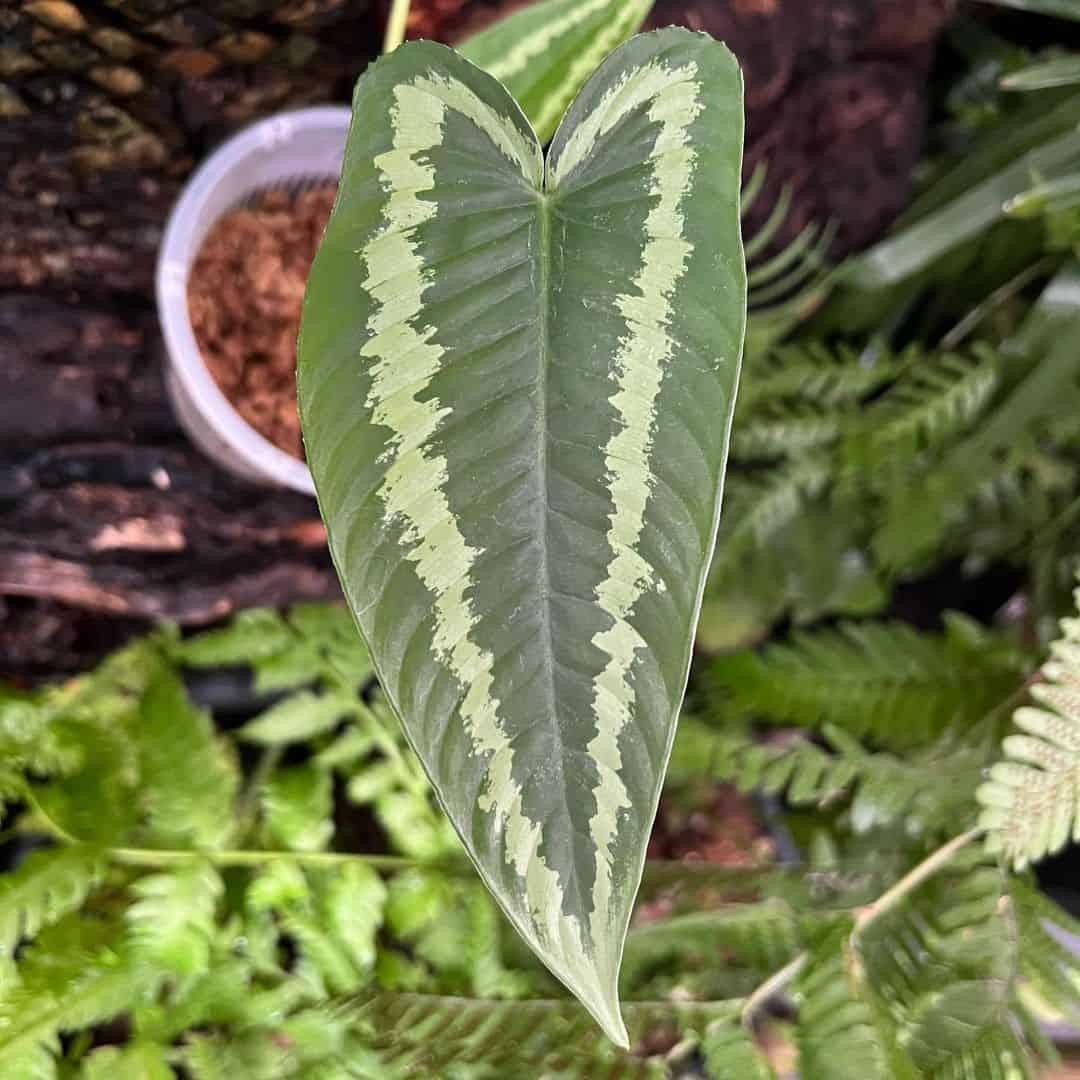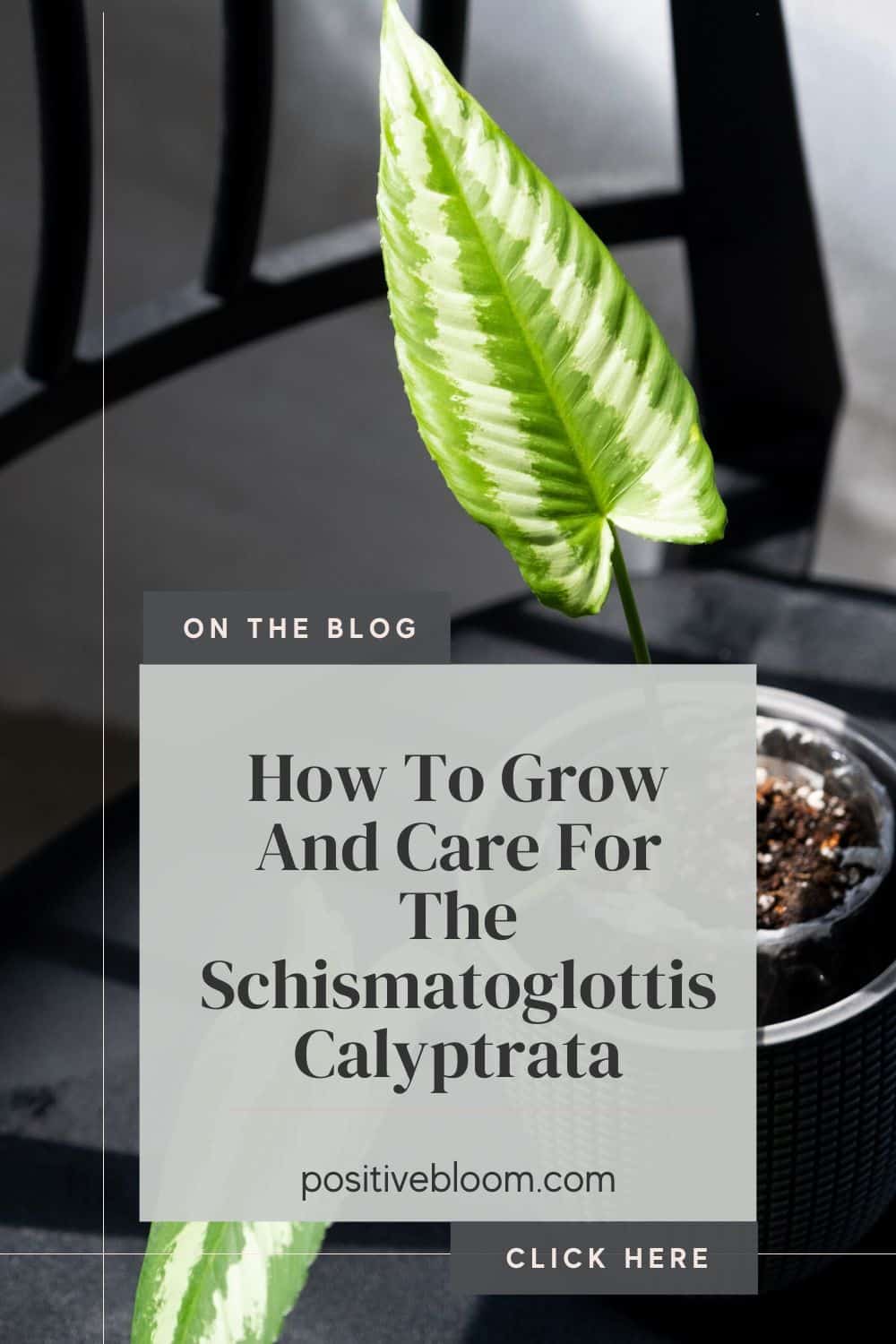If you want to introduce a tropical vibe to your home decor, you can always go with the Homalomena rubescens or any other philodendron or anthurium variety.
But if you want something not all your friends have, you should try growing a Schismatoglottis calyptrata. This plant is an aroid that requires well-draining and fertile soils, moderate temperatures, and indirect light to prosper.
And there’s more to it than meets the eye! This genus is very similar to homalomena plants, so we decided to discuss their differences in order for you to distinguish between them more easily.
And if you want a rare plant to enjoy, we also discuss some schismatoglottis varieties that will go perfectly with your calyptrata.
Before we move on to all that, let’s learn the general specifics about the Schismatoglottis calyptrata:
[table id=510 /]
Variegated Schismatoglottis Calyptrata Plant Care
The Schismatoglottis Calyptrata requires indirect sunlight, water when the topsoil dries out, room temperatures, and well-draining soil.
Of course, we can always expand our knowledge of vascular plants such as this one, and we will help you do just that in the following sections.
Light Requirements
This variegated schismatoglottis requires bright indirect light to produce healthy and colorful foliage.
In order to provide it with the perfect growing conditions, you should keep it on an east-facing windowsill or 3-4 feet away from a west-facing window. You can also protect it with a sheer curtain if the leaf tips turn brown and brittle.
You can even place it under grow lights if none of your rooms get enough sun, but be careful because artificial lights can burn plants. To avoid damaging your schismatoglottis’s gentle foliage, keep it about a foot away from the lights.
Water And Humidity
This flowering plant comes from a tropical climate, but that doesn’t mean you should drown it in water.
It is very susceptible to root rot, which can kill it if you don’t catch it on time. You can easily prevent it, though.
Water the Schismatoglottis calyptrata once the top 2-3 inches of the growing medium are dry to help your plant thrive.
Water your plant slowly until you notice that the moisture has started to drain through the holes in the bottom of the planter.
You should also use rainwater or distilled water when irrigating this plant to prevent mineral build-up that can occur from using tap water.
If you don’t have any other source of moisture, you can use tap water, but always leave it in the air for about 24 hours beforehand.
Humidity
This plant requires high humidity for optimal growth. Just imagine the conditions in Indonesia and Thailand; they’re definitely not dry.
Therefore, you should mist its foliage regularly or use a humidifier to mimic the conditions of tropical climates.
You can also group it with other plants that have similar humidity requirements, such as homalomena and scindapsus, so you have to spray them less frequently.
Temperature
This tropical plant adores warm conditions, and room temperatures between 65-85°F are perfect. It can tolerate slightly cooler conditions, but it cannot thrive if the temperatures are 50°F or lower.
Therefore, try and avoid keeping it near heaters, AC vents, drafty windows, and doors since these spots experience sudden temperature swings, which won’t be good for your schismatoglottis plants.
Soil And Fertilizer
Getting the right soil for your plants is incredibly important. Imagine paying huge sale prices and shipping costs to get this plant, only for it to wither in the following months due to a heavy growing medium.
Therefore, plant your schismatoglottis in a commercial aroid potting mix so you won’t have to worry whether you’ve got it right.
The soil for this plant should also be fertile, so try to look for a variety with worm castings or make your own by mixing orchid bark, perlite, regular houseplant mix, and peat moss.
Fertilizer
You should fertilize this plant 1-2 times per month during its growing season. The good news is that you can use any well-balanced houseplant fertilizer for leafy plants.
Simply dilute it in water following the instructions, and your schismatoglottis will thrive.
If you dislike synthetic fertilizers, you can always turn to organic variants, make your own, or investigate the differences between compost and fertilizer to see whether this soil amendment can help your potted plant.
Repotting
Since this aroid is slow-growing, you don’t have to worry about repotting it all the time. Still, you should move it to a larger container when you notice it has doubled in size or you can see its roots protruding from the drainage holes.
In that case, opt for a pot 1-2 sizes larger, fill it with aroid potting mix, place your schismatoglottis in it, and backfill it with more soil.
Irrigate the repotted plant thoroughly and move it to its regular spot.
If your plant hasn’t increased in size, but you still want to move it to fresh soil, you can follow the same steps from above and just keep it in the same pot!
Propagation
There are many different methods of propagating plants, and the good news is that this herbaceous perennial can be multiplied by the easiest one – division.
All you have to do is learn to recognize the new pups around your plant’s base. Gently separate them from the mother plant using your hands, and if the roots are really entangled, you can cut some with sterilized scissors.
Afterward, fill the new, smaller pot with aroid soil mix, plant the pup in it, water it until the excess moisture drains through the drainage holes, and place it in a spot with indirect light.
Here is a short video that can help you propagate your schismatoglottis for the first time:
More About The Schismatoglottis Calyptrata
The relevancy of this plant isn’t the same for everyone, but it can be an excellent attribute in modern homes with a tropical vibe.
And if you want to learn more about it or find some rare schismatoglottis plants, you should definitely check out the sections below.
Before we go there, let’s examine the looks of the calyptrata. This plant has large, heart-shaped, deep green leaves that are sprinkled with yellow-green and creamy variegations.
This plant doesn’t usually produce flowers indoors, but if you’re lucky, you may notice a spadix that resembles a cob of corn enveloped with a creamy, almost yellow, spathe.
Origin
The Schismatoglottis genus is native primarily to Southeast Asia, although most plants from this genus are indigenous to Borneo.
The plant belongs to the family Araceae and was first published in (Roxb.) Zoll. & Moritzi.
The Schismatoglottis calyptrata is also referred to as Homalomena calyptrata, so don’t let that confuse you. The Homalomena calyptrata is just a homotypic synonym (the old name).
There’s also something interesting about this plant – the natives of Java used to cook the stems, leaves, and flowers to eat them, but nowadays, people usually use them as decorative plants.
Schismatoglottis vs Homalomena Houseplants
The Schismatoglottis genus is frequently confused with Homalomena since many species look alike and have similar growth habits.
However, homalomena plants, such as Homalomena selby, have aromatic foliage, whereas that’s not the case with schismatoglottis.
Schismatoglottis Rare Plants
There are a couple of rare schismatoglottis plants you can grow alongside your calyptrata, such as wallichii, motleyana, and albo.
Schismatoglottis Wallichii
The wallichii variety has pointy, arrow-shaped foliage with gray-green variegations along the midrib.
It is a bit taller than the calyptrata and can reach 2-3 feet.
Schismatoglottis Motleyana
This plant looks like a silver-green Christmas star due to its clumping growth habit and pointy foliage.
It is another variety with gray variegations that would be an excellent addition to any home decor.
Schismatoglottis Albo
The albo differs from the other varieties because it has more rounded foliage and creamy and white variegations.
The colors are sprinkled around the leaves or distributed in larger patches, which only makes the plant more attractive.
Final Thoughts
The main goal of this article was to examine the care guide for the Schismatoglottis calyptrata, a plant that thrives in bright indirect sunlight, has average water requirements, high humidity needs, thrives in moderate temperatures, and adores fertile and well-draining growing mediums.
Of course, the best plant care includes knowledge about feeding, repotting, and propagating, so we presented some tips on these topics as well.
Finally, we know this genus resembles homalomena plants, so we brought more info about schismatoglottis plants to help you tell them apart.Enjoy this rare plant, and until next time!
Like this post? Share or pin it for later!





